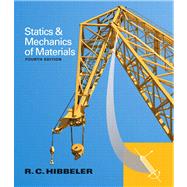Statics and Mechanics of Materials provides a comprehensive and well-illustrated introduction to the theory and application of statics and mechanics of materials. The text presents a commitment to the development of student problem-solving skills and features many pedagogical aids unique to Hibbeler texts.
MasteringEngineering for Statics and Mechanics of Materials is a total learning package. This innovative online program emulates the instructor’s office–hour environment, guiding students through engineering concepts from Statics and Mechanics of Materials with self-paced individualized coaching.
Teaching and Learning Experience
This program will provide a better teaching and learning experience—for you and your students. It provides:
- Individualized Coaching: MasteringEngineering emulates the instructor’s office-hour environment using self-paced individualized coaching.
- Problem Solving: A large variety of problem types stress practical, realistic situations encountered in professional practice.
- Visualization: The photorealistic art program is designed to help students visualize difficult concepts.
- Review and Student Support: A thorough end of chapter review provides students with a concise reviewing tool.
- Accuracy: The accuracy of the text and problem solutions has been thoroughly checked by four other parties.
MasteringEngineering is not a self-paced technology and should only be purchased when required by an instructor.






